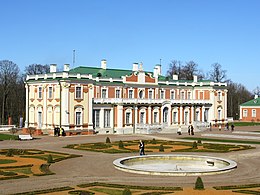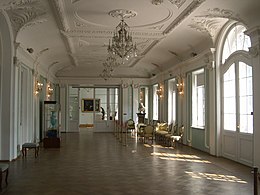Katharinental Castle
| Katharinental Castle | |
|---|---|
 Catherinethal near Tallinn |
|
| Data | |
| place | Tallinn |
| architect |
Nicola Michetti Gaetano Chiaveri Mikhail Semtsov |
| Client | Peter the Great |
| Architectural style | Petrine baroque |
| Construction year | 1718-1725 |
| Coordinates | 59 ° 26 '18.8 " N , 24 ° 47' 27.4" E |
Katharinental Palace (older spelling: Catherinethal ; est . Kadrioru loss ) is a palace built in the Petrine Baroque style, which was built by Peter the Great for Catherine I near Reval in the former Russian Empire (today the Kadriorg district of Tallinn). The palace was built by Gaetano Chiaveri and Michail Semzow after the Great Northern War after Nicola Michetti's designs . The palace currently houses the Kadriorg Art Museum, a branch of the Eesti Kunstimuuseum , which shows foreign art from the 16th to the 20th centuries. The KUMU branch of the museum has been showing Estonian art in the park since the 18th century.
construction
After the successful siege of Reval during the final phase of the Great Northern War , Tsar Peter the Great of Russia bought a small Dutch-style mansion near Lasnamäe for his wife Catherine. Today's house is the result of a drastic renovation ordered by Nicholas I in 1827 .
Plans for a larger palace in the area were soon developed and construction of the new Katharinental Palace began on July 25, 1715. Peter and Katharina visited the unfinished residence on a few occasions, but after the Emperor's death in 1725, Catherine showed no further interest on the property by the sea. The great hall with Katharina's initials and the lush stucco decor (attributed to Heinrich von Bergen ) survived, while many other parts of the interior were redesigned.
The gardener Ilya Surmin was responsible for the flower garden with two fountains and the so-called illusion garden on different levels. The design shows similarities with the park in Strelna .
restoration
After the death of Peter the Great, the palace received more attention from the imperial family. It was visited sporadically by the Empresses Elisabeth and Catherine the Great . From 1828 to 1830 major restorations were carried out on the palace and the surrounding area. Between 1741 and 1917 the palace housed the civil governor of the Governorate of Estonia .
After Estonia declared independence in 1919, the palace became state property. At times, one wing housed the studio of the sculptor August Weizenberg , while the palace was used for art exhibitions. Between 1921 and 1928 the palace housed the forerunner of the Eesti Kunstimuuseum, but in connection with a state visit by Gustav V of Sweden , the palace was converted into a summer residence for the head of state. In 1934 the palace became the official residence of the first President of Estonia , Konstantin Päts , who moved in with expensive and controversial restorations with the aim of converting the park and palace into his private residence. Since that time, the library, in the lavish so-called Danzig Baroque style and completed by the architect Olev Siinmaa in 1939, has been particularly worth mentioning. A purpose-built presidential palace for this territory was designed by Alar Kotli in 1938 .
During the German occupation , the palace was the residence of the civil governor, Karl-Siegmund Litzmann . After 1944, during the Soviet occupation of Estonia , the palace once again served as the main location of the Estonian Art Museum. But the building has been neglected and was in ruins when Estonia gained independence in 1991. Restorations, co-financed by the Swedish government , began in 1991 and the palace opened in 2000. It was also decided that a new building should be built near the Kumu . From 1993 to 2005 part of the collection could be viewed here in the house of the Estonian Knighthood in Tallinn's city center.
The restored palace was reopened in the summer of 2000, but no longer serves as the main location of the museum, but as the location of the museum's collection of foreign art. This houses paintings by Bartholomeus van der Helst , Gillis van Valckenborch , Jacob Jordaens , Lambert de Hondt , Adriaen Cornelisz. Beeldemaker , Maria Dorothea Wagner , Bernardo Strozzi , Pietro Liberi , Anton Graff , Angelica Kauffmann , Francesco Fontebasso , Cornelius Schut , Michail Clodt von Jürgensburg , and Ilja Repin .
gallery
| facade | foyer | Palace in winter |
Web links
- Site of the castle museum (also in English)
Footnotes
- ^ Art Museum of Estonia . Retrieved February 16, 2013.
- ↑ a b Kadriorg . In: Tallinn in your pocket . Retrieved April 11, 2013.
- ↑ a b Кадриорг . In: Estonianet.ru . Retrieved April 11, 2013.
- ^ Peter Hayden: Russian Parks and Gardens. ISBN 978-0-7112-2430-8 , p. 74.
- ↑ a b c Palace and Its Story . Archived from the original on February 21, 2013. Info: The archive link was inserted automatically and has not yet been checked. Please check the original and archive link according to the instructions and then remove this notice. Retrieved February 16, 2013.
- ^ Neil Taylor: Estonia . Bradt Travel Guides, 2010, ISBN 978-1-84162320-7 , p. 116.
- ^ About the museum . In: Art Museum of Estonia . Retrieved April 11, 2013.



